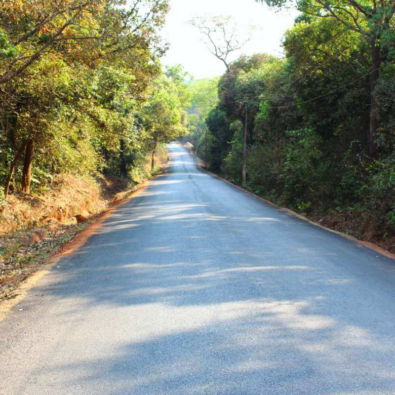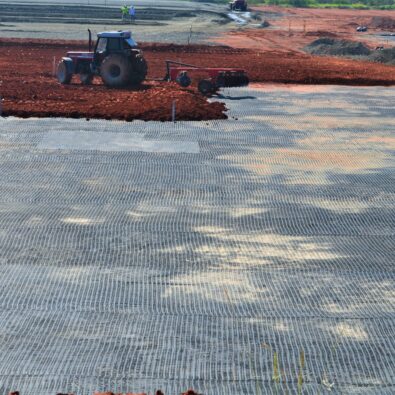How can we reduce the carbon footprint of road construction?

Road construction relies on resource-intensive practices, influenced by the soil mechanics of the development site. Each region poses unique challenges, often addressed through traditional solutions. Here, partnering with a geosynthetics manufacturer like Strata Geosystems can provide infrastructure companies with cost-effective and sustainable solutions for pavement design. Strata Geosystems offers an array of purpose-built products, including StrataWall (retaining walls) and StrataGrid, designed to address diverse soil mechanics challenges in highway, asphalt, and unpaved road construction. This exploration aims to delve deeper into the role of geosynthetics in reducing carbon emissions in road construction, placing a spotlight on the groundbreaking products offered by Strata Geosystems and its impact on road construction.
How can the carbon footprint of asphalt roads be significantly reduced?
Processes like clearing green cover, paving roads, improving subgrades, and transporting materials all contribute to greenhouse gas emissions. This raises an important question: can roads be constructed without a significant carbon footprint?
1. Local sourcing for reduced transportation emissions:
Strata Geosystems prioritizes local sourcing of materials to reduce transportation emissions. The rationale is simple yet powerful – proximity reduces the need for extensive transportation, resulting in a substantial reduction in carbon emissions. This approach aligns with environmental goals while benefiting local economies.
2. Low-carbon and lower project costs:
Low-carbon alternatives include geosynthetics for soil stabilization, wall reinforcement, and layer separation. The aim of a construction project is twofold – cost optimization paired with longevity. The incorporation of lower carbon concrete and innovative asphalt solutions propels the industry towards a greener future, demonstrating the transformative power of material choices. By reducing the need for subgrade stabilisation, ground improvement, minimising the time taken for wet ground to dry, reduced transportation cost for trucks ferrying materials, and protecting groundwater from contamination through the use of geocomposites. Many costs [be it financial, or ecological] get minimized by simpler, and more effective soil stabilization techniques.
3. Adjusting subgrade layers for carbon reduction:
The thickness of road layers significantly affects carbon reduction. Strata Geosystems encourages finding the optimal balance in soil/traffic dynamics during the design phase through its design consulting services. This not only optimizes the road’s performance but also contributes to an overall reduction in the project’s carbon footprint. Pavement thickness is often influenced by terrain, temperature, soil compactness, and soil angle of repose. This in turn affects the planning and designing of the pavement to be constructed. In applications requiring soil reinforcement, geogrids (uniaxial or biaxial) improve the mechanical performance of the soil layer through reinforcement and confinement, enabling a reduction in the required pavement thickness.
4. Balancing sustainability and practicality:

Whether you are building a road in a water saturated coastal belt or in an arid desert, the need for design intervention with sustainability is key. Here, we assist each project with the evaluation stage, find the right mix of products to address the foundation design, minimize the maintenance cycle, and overall enhance longevity. For example, StrataGrid is a PET grid designed for wall slopes and embankments for soil reinforcement. Be it weak soil, high water content, groundwater contamination, or erosion control –all of these instances need soil stabilization. The most common method of achieving this is mechanical soil stabilization –which includes compaction of soil, mixing it with other matter such as nano materials, lime, fly ash, etc., and reinforcing it. However, geogrids provide an alternative by being layered between subgrade, and aggregate and acts as a reinforcement layer which distributes loads, prevents soil erosion and fixes the soil. As a result, it improves the ability of the soil mass to resist internal and external forces, increasing the factor of safety against slope failure. The design process takes into account soil composition: mineralogy, grain size, grain size distribution, shape of particles, pore fluid type, and content, ions on grain and in pore fluid.
Due to the high tensile strength of geogrids the shear strength of soil sees an improvement. This in turn means you are looking at the durability of the paved road, no matter where your project takes you.
Here are the common questions about geogrids:
Right from understanding the purpose of geogrids, to its benefits, how they work to cost considerations – there are many questions around the usage of geogrids in highway construction. With the benefits of overall material minimization, these products are a viable and sustainable long term solution for roadways. Depending on the site, the specifications of the roll you use will change, as will the aperture and tensile strength of the geogrid. Road engineers may find a wide range of unexpected conditions during road construction –from waterlogging to topsoil erosion and soft soil. The cost of geogrid installation varies from project to project. Here, we address the most common questions we receive.
1. Are geogrids only used for soil stabilisation in roads?
The most common application of geogrid is soil stabilization across a wide range of industries – be it highways, railways, airports, haul roads or trafficked roads. However, they are used for retention walls, slope stabilization, embankment reinforcement where there is a weak soil. Railway track beds also are common sites for geogrid usage to stabilize the subgrade over which the tracks are laid, and to minimize the maintenance costs.
2. Can geogrids be used for major highways only?
Geogrids can be used across all types of roads. Right from national highways, state highways, district highways, parking lots, unpaved roads, asphalt roads, haul roads, and ports, the options are numerous. The decision to use a specific type of uniaxial, or biaxial, geogrid depends on factors such as soil conditions, traffic loads, and the specific requirements of the project. Since products such as StrataGrid are made from high tensile polyester, they are also able to withstand extreme pH conditions, and water levels, and work efficiently to distribute loads for a range of subgrade types.
3. Can geogrids only be used for soft soil conditions?
While geogrids are often deployed in soft soil conditions to improve stability and prevent issues like rutting, we recommend evaluating the project specifics to understand all the different soil types where it can be used. For example, in cohesive soils, geogrids can improve load-bearing capacity and minimize settlement, while in granular soils, StrataGrid improves load distribution and reduces rutting. Since our geogrids are made from polyester yarns, they are precision knitted into a dimensionally stable, uniform network of apertures providing significant tensile strength. Our Soil Interaction Coefficients for Pullout (Ci ) and Direct Sliding (Cds) for SGU Series (uniaxial geogrid) allow for usage across silts/clay, sandy silts and clay, poorly-graded sand and gravel, silty sand, and well-graded gravel and sand.
4. Are geogrids a one-size-fits-all solution?
Selection and design of geogrids require consideration of soil type, including its gradation, compaction, and shear strength characteristics, as well as the expected loading conditions, including static and dynamic loads. For example, our uniaxial geogrid variants alone are capable of withstanding up to 160kN/m when tested by the ASTM D 6637 Method B Wide-Width method.
5. Can geogrids replace proper pavement design?
Pavement design is a branch of engineering that involves traffic analysis, subgrade evaluation, material selection, thickness design, drainage design, construction specification alongside a clear understanding of the resource planning and requirements of the site. Geogrid usage falls within the remit of evaluating subgrade quality, and using geosynthetics to strengthen, reinforce and enhance the stability of the overall structure. Geogrids are part of pavement design considerations but cannot replace the expertise of a licensed site consultant.
6. Can geogrids be used with asphalt or concrete pavements?
Geogrids can be used under both asphalt and concrete surfaces. With both materials, the impact and result of geogrid usage varies. In asphalt pavements, the roll is placed between the base and subbase layers or within the asphalt layer itself to improve the pavement’s resistance to fatigue cracking and rutting. By distributing traffic loads through its interlocking structure, the geogrid reduces stress concentrations on the subgrade, which helps extend the pavement’s service life. In case of concrete pavements, it enhances resistance against cracking and minimizes the occurrence of joint spalling. Geogrids are also utilized to reinforce concrete overlays on existing pavements. Be it pavement rehabilitation, pavement widening, erosion control, or isolated soil stabilization – these highly flexible rolls can be deployed across all these instances.
7. How to choose the right geogrid for your pavement, or road construction?

Geogrids are polymer-based grid structures with apertures that enable soil particles to interlock with the material, preventing displacement and reducing lateral movement. The inclusion of a geogrid creates a composite system that provides a structural benefit equivalent to using a subgrade material with a higher California Bearing Ratio (CBR). This allows designers to reduce the thickness of the aggregate layers while achieving the same performance. Note: at this point, we won’t dive into the relative conversion metrics for both measures, but instead focus on the net impact on subgrade quality. In turn, it minimizes the need for thicker pavement and helps reduce material costs. Choosing a specific type of geogrid is dependent on the CBR value of the sub-base soil. Geogrids help with load distribution and as such allow the reinforced pavement to carry heavier loads. With proper design, planning, and use of Strata Geosystem products, one can achieve a cost-effective pavement system and minimize carbon emissions.
The entire lifecycle of roadways construction and management benefits with the use of geosynthetics. Whether it’s in the need for excavation for subgrade, need for additional materials for strengthening, or prevention against other climatic factors. Therefore, while achieving net carbon neutrality might be some way away, today, with a plethora of products we can encourage better processes in highway engineering.
